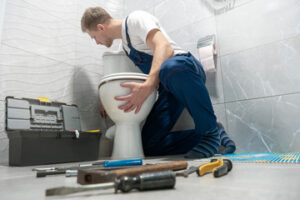Plumbers Cranford NJ install and repair the pipes that deliver water and gas to, and remove waste from, homes and businesses. They may also work on plumbing fixtures such as bathtubs, sinks and toilets.

Plumbers must be able to read and interpret blueprints and architectural plans in order to plan pipe layouts. They must also have good problem-solving skills to fix issues that arise during work.
An old saying in the plumbing trade is that “a quarter turn of the handle means a quart of water goes down the drain.” This is because leaks are not just annoying; they can lead to expensive damage to your property over time. If you suspect you have a leak in your faucet, a plumber can use advanced tools to pinpoint the exact location and cause of the leak, such as sonic leak detection devices.
Sediment Buildup
Sediment is a foreign material that enters building water systems from a variety of sources. These include soil runoff, sediment from construction activities, and infrastructure-related deposits. These sediments can damage piping and equipment, inhibit secondary disinfection, and encourage bacterial growth. In addition, they can also impart a brown tint to water and reduce water pressure. In some cases, the presence of such sediments can even result in a full sewer line blockage.
In many instances, clogged drains caused by sediment buildup can be prevented with regular maintenance. For instance, using a drain guard can help catch hair or other particles before they can cause a clog. In addition, regular flushing of drains with hot water can help dissolve and dislodge sediment. It is also a good idea to use a drain snake or plunger to clear stubborn clogs. In severe cases of sediment accumulation, however, it may be necessary to consult a professional plumber.
The most common type of sediment in building water systems is sand and silt. During rainstorms, these materials can seep through cracked pipes and enter plumbing fixtures and appliances. They can also be introduced into buildings through sewage backups and other drainage-related problems.
Another common source of sediment in water systems is rust. This is typically caused by old iron pipework or the deterioration of water heaters (calorifers). It can give water a metallic taste and stain laundry, fixtures, and appliances. Rust can also degrade piping, increasing the risk of leaks and other problems.
When noticing a brown tint or reduced water flow, a property owner should immediately contact a plumber to inspect and repair their plumbing system. If the problem is not addressed promptly, it can lead to serious issues that require extensive repairs or even pipe replacement.
To prevent the occurrence of such issues, it is recommended that plumbing systems be flushed at least once a year. A professional plumber can use specialized tools to blast away sediment buildup and ensure that plumbing systems are free of debris. They can also assist with implementing strategies that help to manage the formation of sediment in the future. These measures can include establishing a program of regular descaling and installing a water softener to reduce limescale buildup.
Damaged Pipes
Pipes are a critical part of your plumbing system, so when they break, it can cause major headaches. Luckily, if you keep an eye out for the warning signs, you can spot these problems before they turn into costly repairs.
One of the most obvious indications of broken pipes is wet spots on your ceiling or walls. This is a sign that the water pipe has burst and can cause significant damage. The best way to avoid this is by having a professional plumber check your pipes regularly, so they can catch any problems before they happen.
Another warning sign is gurgling or hissing sounds from your plumbing. These are caused by a buildup of naturally occurring iron in your pipes and are a sure sign that a pipe is burst. If you notice a rotten egg smell, it is likely caused by hydrogen sulfide and also indicates that your pipes have been damaged.
A broken pipe should be fixed as soon as possible to prevent further damage and water leaks. The first step is to shut off the water supply to the area, then carefully examine it for damage. If the pipe is in a wall or ceiling, it’s important to protect yourself with a heavy duty pair of safety gloves and a face mask. Before starting work, clean the area around the pipe with a damp cloth or sponge to remove any dirt or grease. It’s also important to dry the area thoroughly and make sure that the repair product you choose works with your type of pipe.
If your pipes are made of copper, galvanized steel or plastic (like PVC), there are several ways to make a temporary repair. You can use a pipe clamp, a rubber patch or epoxy putty to seal the crack. However, these methods are only a short-term solution and should be replaced by a plumber who can provide a permanent fix. If your pipes are leaking, it’s important to turn off the water supply and call a plumber immediately for assistance. Water can quickly damage your property and lead to mold growth, so it’s important to act fast.